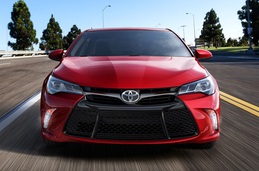 - image courtesy of Toyota -
- image courtesy of Toyota - Two creative approaches to automobile advertising have caught my eye of late: spots on TV and online for Cadillac’s revolutionary new CT6 luxury performance sedan and a television / online campaign for Toyota’s competent but non-revolutionary Camry. One campaign engages the mind, the other tugs at the heart. One campaign is daring, the other is bold. One is cool and self-centric, the other warm and other-centric. Both ads are effective.
Let’s start with Toyota, for whom Saatchi, LA has created a series of spots declaring the heretofore ordinary Camry now to be bold – at least by association, because the car only plays a bit part in the ads. The real drama happens in stories that wrap themselves around the car:
A young woman finds B.B. King’s guitar in a storage unit, and after “tracking down a legend” in her Camry, returns it to him. |
 - image courtesy of Cadillac -
- image courtesy of Cadillac - Like Cadillac and other auto brands (Buick has been notably successful), Toyota has been trying to crank up their style to generate wider appeal. Will their “Bold” campaign help attract new buyers, as cars like Ford’s fast-selling Fusion (with a much cooler name) take a bead on Camry’s sales lead?
Marketing experts are divided. Some say Toyota is headed in the right direction with their Bold campaign but that turning around brand impression takes years, if not generations. Other say “not so fast,” a Camry is a Camry and no matter how good it may become, it was born to blend in.
Cadillac, too, is all about changing prospective buyers’ impression of their brand – and in recent years they appear to have been succeeding for the most part. In fact, they appear to have just about exorcised the image of the slab-sided, boat big ‘80s and ‘90s models from people’s minds. Short of buying up and crushing all the clunky old Caddys left on the road, about all Cadillac can do is (1) design cars that truly stand out in their market niche and (2) have something truly bold to say about them.
Thus, the CT6 “Dare Greatly” campaign, created by Publicis Worldwide, a low-key exercise in creative edginess that presents the car in SoHo, slo-mo style.
- “How does a fashion intern (Jason Wu) become an arbiter of style?” the spot asks.
- “How does a college dropout invent the personal computer?” it asks of Apple co-founder Steve Wozniak.
- “How does a director take 12 years to shoot a film?” the spot asks of “Boyhood” director Richard Linklater.
- And in conclusion also asks, “How does a 112 year old carmaker reinvent itself?”
The CT6 launch ad, created by Publicis Worldwide and set to Edith Piaf singing Non, je ne regrettes rien (No, I regret nothing), presents thumbnail descriptions of “only those who dare” in a noir-like New York setting that evokes a sense of mystery and glamor as the newest Cadillac lurks in the background, almost as if an afterthought.
One does not so much “like” this ad as inhabit it – that is, if you’re in the demographic that GM hopes will lust after this car, which has been designed to raise the game against their European competitors, not so much by emulating them but by establishing a new standard of automotive performance and luxury.
The CT6 and Camry ads both wrap their product in an image they hope will attract buyers – Camry warms the heart and speaks of “love stuff” while Caddy quickens the pulse and addresses the “daring”.
Both carry off their creative well. But only Cadillac’s approach seems authentic.
Ironically, I prefer watching the Camry spots (which makes me older-than-cool and more in their target market). I like Camrys, which perform their middle-ground, mid-sized sedan function admirably and without pretending to be cool. When I rent one on an out-of-town trip, I am assured of enjoying a competent, quality, unpretentious ride. Which is what makes a Camry a Camry and part of the reason that nameplate remains the best-selling one in the U.S.
I think of Margary Williams’ story of The Velveteen Rabbit when considering whether Toyota may be missing the strategic mark with its otherwise well-executed Camry creative. You may recall the story, where a stuffed bunny yearns to become “Real”.
“Real isn't how you are made,” the rabbit is told. “It's a thing that happens to you. When a child loves you for a long, long time, not just to play with, but REALLY loves you, then you become Real."
Camry is already “real” in its market’s mind. So why go to such lengths to pretend it really is something else?
TakeAway: Don’t sell bold unless you’ve got bold to sell. Instead, communicate what’s really real. Be authentic!
Content © by Brian E. Faulkner

 RSS Feed
RSS Feed